While at the 5th Annual Jeeps Unlimited Moab Run in May, 2005, my power steering pump that serviced the Hydroboost and my steering box was fading fast (and I do mean fast). Vanco helped me out and we got a pump from PSC sent over-night to my motel. It was a temporary fix as I was waiting to install a new pump with a remote reservoir once it became available. Enter Performance Off-Road Systems from Wetumpka, AL. I spoke at length with the owner, Sean, about pumps and other hydraulics. His company does a fair amount of steering setups, rams, and ram assists. Sean sent out a pump and reservoir and I picked up the hoses and hose fittings locally and ordered a mounting bracket from PSC.
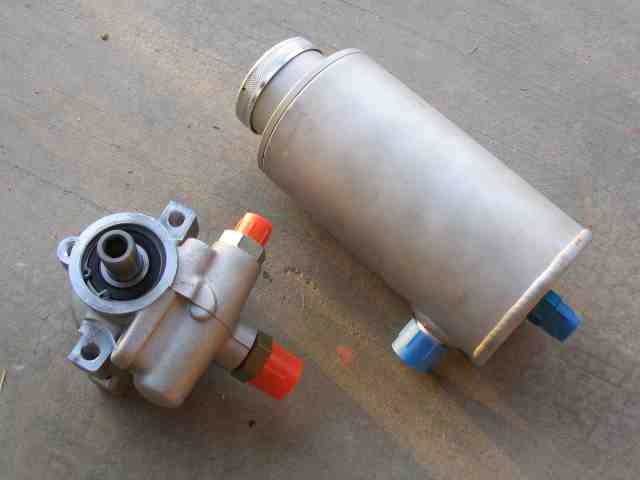
This wasn’t a “kit” so it was up to me to obtain the necessary hose and connectors to get it into the TJ. The pump is rated at 4 GPM (Sean says it will flow a bit more than at) at 1450 PSI. The remote reservoir holds more fluid than the smaller reservoir that is attached to the factory pump. The reservoir has a return fitting on the bottom while the suction connector sits low on the side of the can.
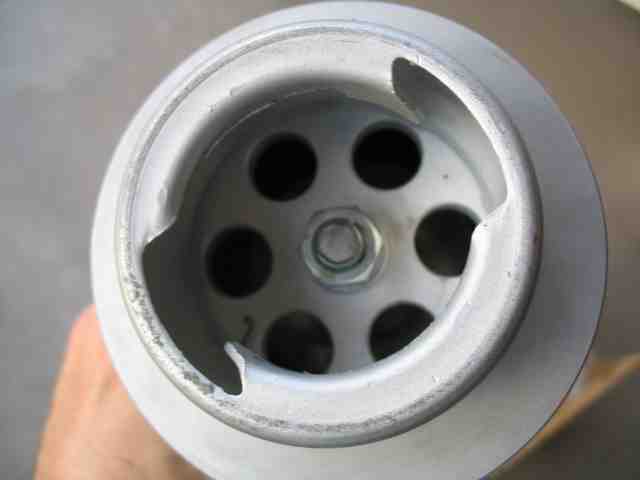
The reservoir contains a filter which also serves as a baffle. This is the top of the reservoir. Power steering fluid will expand a bit when it gets hot so don’t fill it to the top. The larger reservoir also serves to act as a cooler (of sorts). It doesn’t replace a regular PS cooler, in my opinion, but having this remote mounted from the pump gives you more fluid capacity and a cooler running system.
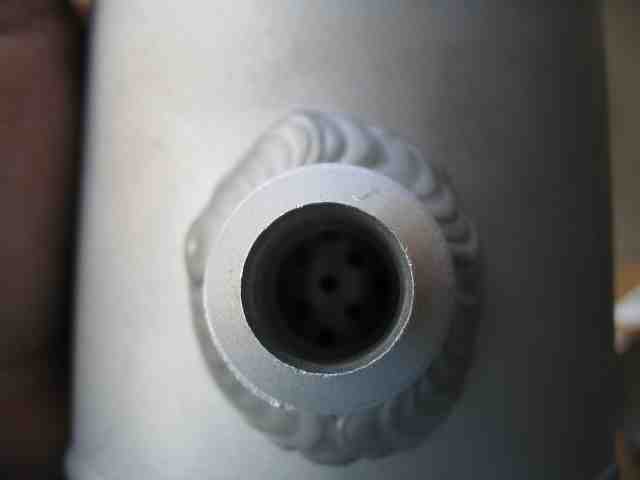
A quick look into the suction port reveals a bit of the filter that is mounted in the reservoir. The outlet is a -10 AN fitting and the return line is a -6 AN line.
My original PS pump configuration (from Vanco) had the return lines from the steering gear box and the Hydroboost coming together at a T fitting and then going into the pump reservoir. While this works, I am pretty sure that the flow is being restricted prior to reaching the reservoir (when the flow is at maximum).
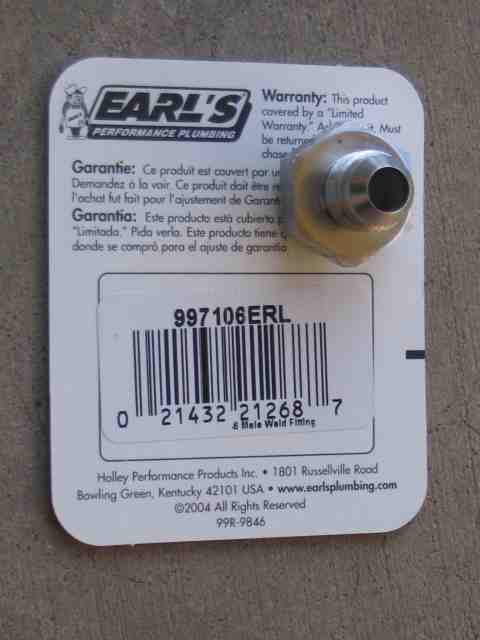
Having two return lines going into the reservoir would be the ideal setup. Unfortunately, that can not be easily achieved with the stock pump reservoir. I picked up a weld in male -6 fitting to add to the new reservoir. This particular one is made by Earl. I believe the part number in the above picture is the Earl # and not the inventory number from the store I got it at, which was a performance speed shop. A good friend of mine was kind enough to weld it to the reservoir once I had made the hole in the reservoir. The fitting runs about $4.
Power Steering Pump & Remote Reservoir
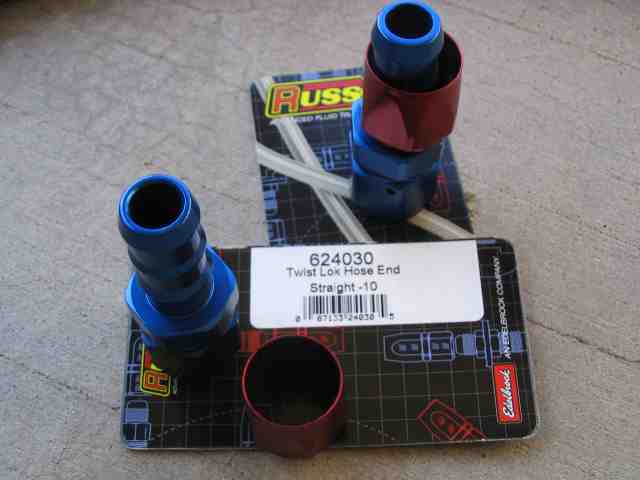
Next comes the fittings for the suction line that connects the reservoir to the pump. I picked up a pair of Russell -10 Twist-Lok fittings, part # 624030. This specific connector is NOT designed for high pressure applications (such as power steering). Basically, they are an AN-10 female fitting with a hose barb on the other end. Using a Twist-Lok connector in a high pressure application would be a mistake. But for the suction line, these are just what the doctor ordered. They cost about $9 each.
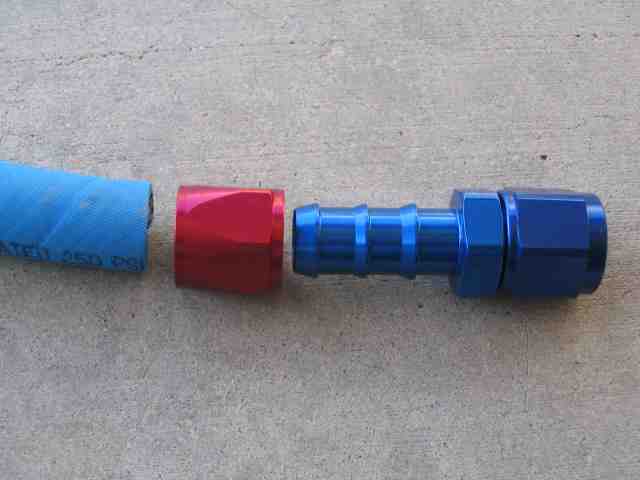
The Twist-Lok fitting is a slip fit. The red ring has a slit down it that can be expanded with the blade of a screw driver. This is spread and slipped down over the hose. The hose is then pushed onto the fitting until it is snug up against the shoulder of the fitting. The red ring is then expanded again and slid up over the hose until it butts up against the fitting body.
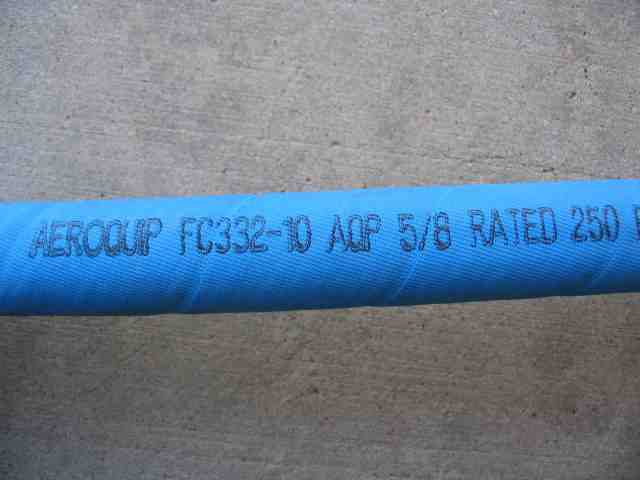
A pic of the hose I used for the suction line. Made by Aeroquip, this hose is -10 (5/8″) diameter and rated at 250 PSI. This hose is fairly rigid, which is needed, so the line does not collapse flat from the suction of the pump. (the same way you can collapse a drinking straw by sucking too hard on it) The cost is about $5 per foot. I asked for 2 feet and the counter guy had an end of the roll piece that was 31″ long so I got the extra half foot for free.
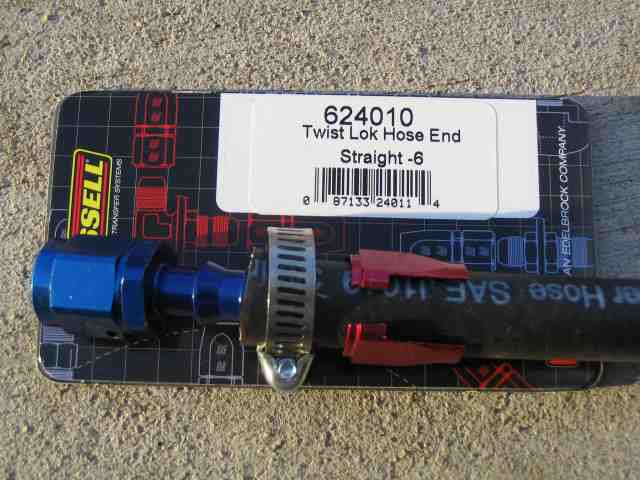
I also bought a pair of Russell -6 Twist-Lok fittings for the low pressure return lines. These will connect the return lines to the reservoir, those from the hydroboost and the steering gear box. The fittings were about $5 each at the local Checker Auto store.
The hose clamp in the above pic was not included with the fitting. I am opting (unless I change my mind), to use the hose clamps on these low pressure return lines. These barb fittings are rated for 250 PSI without using any clamp, per Russell’s specs. However, I am thinking that I would just as soon be on the safe side here. Having a hose come loose out on the trail would be the pits and it would make a mess that requires a good clean up…..avoiding the entire situation would be just fine by me.
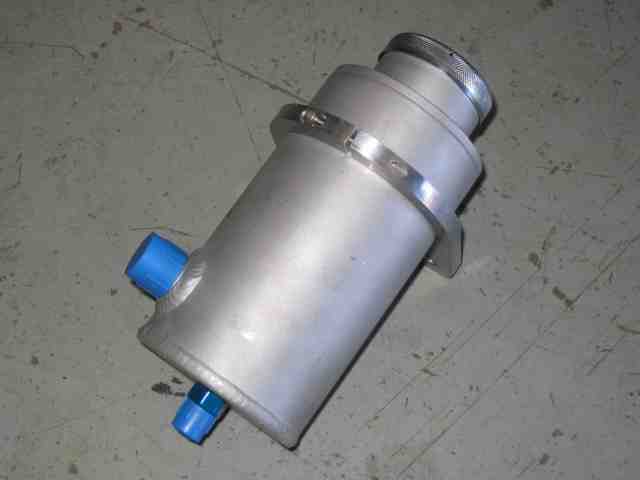
I got the mounting bracket from PSC earlier in the week. Prior to ordering it, I verified that the reservoir they sell with the pump kits was the same diameter as mine. Once the size was confirmed, I had the bracket at my house in a few days. It is an aluminum bracket that has 4 mounting holes and clamps around the reservoir.
Power Steering Pump & Remote Reservoir
Install day arrived (that means I had a day off from work) and I headed up to Troy’s shop to do the work. We had previously discussed his welding the extra connector to the reservoir. If I found the appropriate fitting and made the new hole, he would fire up the new Lincoln and make it happen.
I needed to mock up the reservoir mounting location so I could determine the appropriate spot for the reservoir’s new fitting. It didn’t take long to disconnect the PS lines from the existing pump and remove it from the stock mounting bracket. (For more step-by-step details on doing the pump removal, check out this PS pump replacement write-up.)
I had asked Sean about running a stock or undersized pulley on his pump. He told me that I could use either one. I have a PSC undersized pulley but you can not mount the pulley onto the pump and then bolt the pump in place. The smaller diameter pulley does not allow the holes in the pulley to line up properly with the pump’s three mounting bolts. I took the easier route and opted for using my stock pulley.
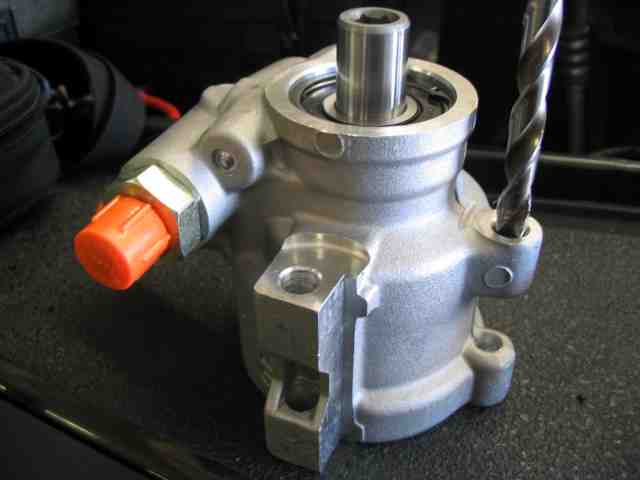
Before I could mount the pump to the bracket, I decided to remove the threads from a pair of the mounting tabs. The center section was tapped and the bolt size/pitch matched the stock mounting bolts….but I could see no reason for them so out they came. A 5/16″ drill bit made short work of them. With the threads out of the way, I slipped the pump into the mounting bracket and used a single bolt to temporarily hold it in place while I got the reservoir ready to mount.
As I write this, I realize I missed taking a close-up picture of the mounting bracket while I was making it. This bracket was made from some 1.5″ wide steel flat stock, about 1/8″ thick. I cut a piece that was the same length as the aluminum reservoir bracket. The reservoir bracket has four 5/16″ holes in it. I transferred the hole pattern to the flat stock and punched out the holes. The steel bracket was then bolted to the aluminum reservoir.
With a flapper disc attached to a 4″ angle grinder, I removed the paint from the driver’s side grill support rod, near the vicinity of the power steering pump. I temporarily removed the radiator overflow bottle and the TJ’s windshield washer reservoir. I needed some space and these were in the way as I tried to position things, measure for hose length, etc. As I found what I thought was a suitable route for the hose connections, I would slip the washer reservoir into place to ensure I had proper clearance. Satisfied that I found a suitable location for the reservoir, I marked the spot on the reservoir where the hole would be drilled for the AN fitting.
 Before I could drill the hole in the reservoir, I needed to open it up and temporarily remove the filter. I did not want the filings from the drill getting into it. I removed the nut at the top of the baffle plate, which also serves as the top of the reservoir. With a bit of effort, the top was pulled out of the reservoir. The rubber o-ring, as seen in the above pic, keeps it snuggly in place.
Before I could drill the hole in the reservoir, I needed to open it up and temporarily remove the filter. I did not want the filings from the drill getting into it. I removed the nut at the top of the baffle plate, which also serves as the top of the reservoir. With a bit of effort, the top was pulled out of the reservoir. The rubber o-ring, as seen in the above pic, keeps it snuggly in place.
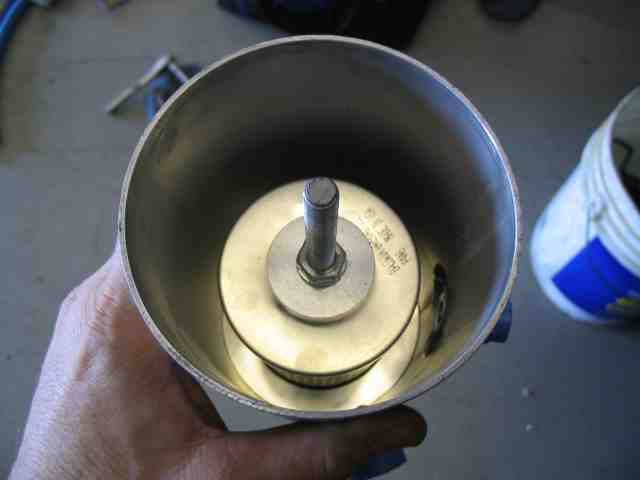
You can see the filter in this pic. It is held in position with an aluminum filter retainer and another nut on the threaded rod. I removed the nut, the retainer, and finally the filter.
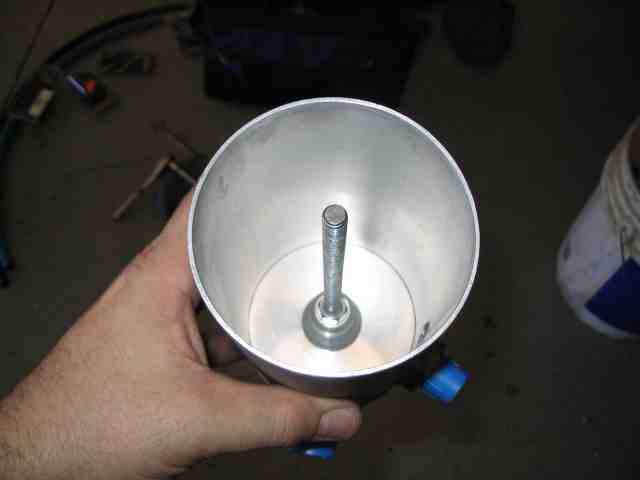
With the filter out of the way, it would be easy enough to clean the filings out of the reservoir after I finished drilling the hole. After making a small pilot hole in the reservoir, I finished the job with a step drill bit. They work great for this kind of task when you need a hole about 3/4″ in diameter.
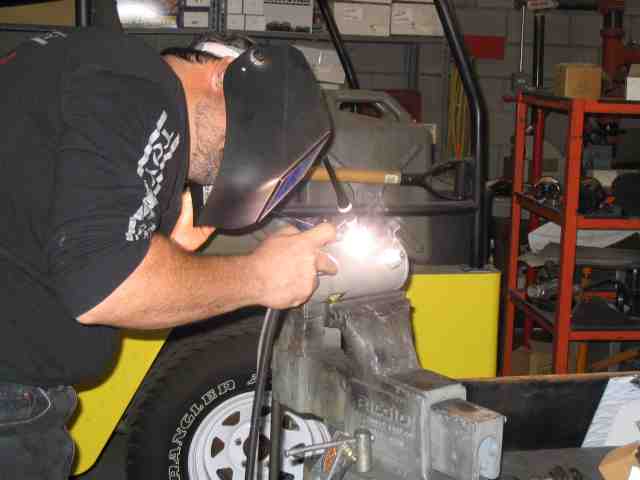
I handed the gutted reservoir, with a fresh hole in it, over to Troy. A couple of minutes later, I had one very hot reservoir with a brand new -6 male AN fitting welding into place. Thanks Troy!

When the reservoir had cooled, I installed the filter, put the top back on the unit, and slipped it back into the aluminum mounting bracket. I bolted the aluminum bracket to the steel bracket with 4 mounting bolts. I then clamped the steel bracket onto the grill support rod with a Vise Grips. After rechecking the location one more time (I wanted to make sure it would clear everything), I tacked it in place with the welder. After another check to make sure I could route the hoses in the manner I wanted, I welded the bracket to the support rod. (Did I mention this is one of those measure 3 times, weld once kind of steps?)
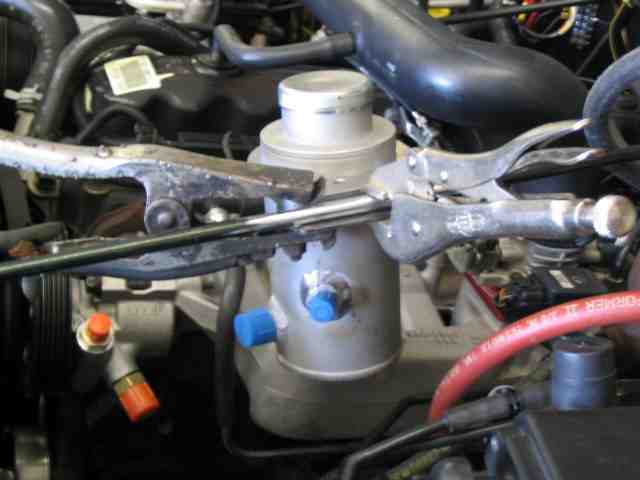
Here is a pic I snapped after the install was done. You can see the mounting bolts on the aluminum reservoir bracket. As I said previously, it is bolted to the steel bracket that I welded to the support rod.
Power Steering Pump & Remote Reservoir
With the pump reservoir tacked into position, I turned my attention to making up the suction line from the cool blue hose I had bought.
The Twist-Lok fittings are easy to assemble. First, ensure the end of the hose is cut squarely. If it is not, use a sharp knife to make it so.

Slide the red cover over the hose, pushing it onto the hose about 4″. Push the Twist-Lok fitting into the hose. You are done when the shoulder of the fitting is flush against the end of the hose. Using a screwdriver (or something similar), pry open the cover a bit, sliding it towards the end of the hose until it too is flush to the edge of the connector.
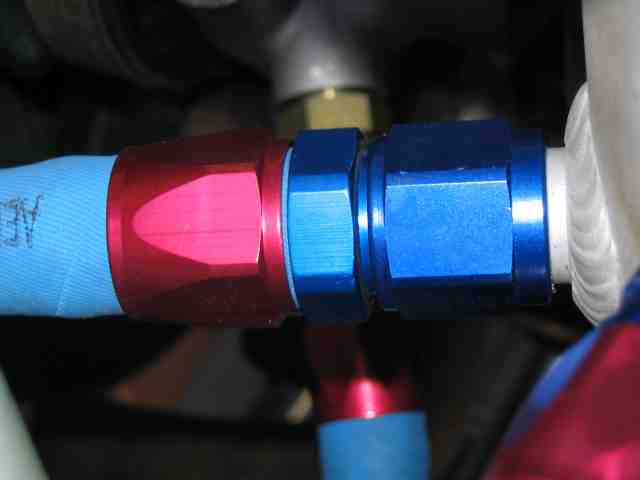
Here is the -10 fitting after it was attached to the Aeroquip hose and then connected to the reservoir outlet port. Remember that the Russell fittings shown here are made from aluminum. You should NOT be leaning on the wrench too hard. Just a good snug fit is all that is required for a leak free connection.
Remember to watch your bend radius on the Aeroquip hose. If you try to change directions with it too quickly, it will start to collapse. The larger the hose, the bigger the bend radius. In the above pict, you can see the other -10 fitting in the background, which connects to the pump’s inlet port. I routed the hose in 270 degree bend between the reservoir and the pump and used about 20″ of hose. I could have used less hose by employing a couple of 90 degree fittings but opted not to. Some of the folks that are more in the know about power steering systems say that the 90 degree fittings can reduce the flow and lead to lower performance.
Once the 5/8″ suction line was plumbed, I turned my attention to the two remaining 3/8″ return lines. The existing low pressure return line from the Hydroboost was more than long enough to do the job. I cut about 6 inches off of it and then attached the -6 Twist-Lok fitting, using the same method as I did on the suction line. When the Twist-Lok fitting was attached, it was screwed onto the -6 fitting that Troy had welded onto the side of the reservoir. The remaining line that needed another -6 Twist-Lok fitting was the low pressure return line from the steering box. Since I have a power steering cooler in my system, the return line actually comes out of the cooler and attaches to the inlet port on the reservoir. The low pressure line from the cooler was not long enough to reach the reservoir. I had a hunch this was going to come up short and had already purchased a three foot piece of low pressure line. I was lucky as that piece was just long enough to reach. I had guessed on length and almost came up short.
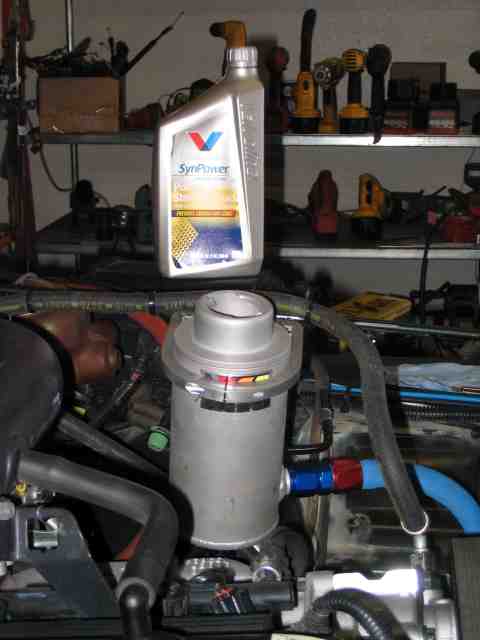
With the last of the return lines attached to the reservoir, I opened a quart of Valvoline SynPower power steering fluid and started filling the reservoir. I added about two-thirds of the bottle.
With the reservoir filled, it was time to bleed the power steering system. First, I let it set UNDISTURBED for a few minutes while I rechecked my work (hose fittings, clamps, mounting bolts, etc.) Now is a great time to discover that you neglected to tightening that one fitting….better now then after it is under pressure and spraying down your engine compartment with high pressure power steering fluid! I wiped down the pump body, reservoir, and all the fittings so that any fluid leak could be easily detected.
Using a floor jack under the center of the front axle, I raised it until one of the tires cleared the ground. WITHOUT STARTING THE ENGINE, I slowly began turning the steering wheel lock to lock. The word SLOWLY is important….it means about 1 revolution of the wheel every 8~10 seconds. Continue to add fluid to the reservoir as necessary. As I slowly worked the steering wheel back and forth, the fluid level rose and fell a bit as the bubbles worked their way out of the lines. After about a dozen lock to lock turns, I checked the reservoir level. I added 6 oz. of fluid to bring it back up to the same point where I initially filled it. I did another half dozen lock to lock cycles. The fluid level barely changed compared to before. Time to check for leaks.
There were no signs of leaks on the new fittings I had installed. Satisfied that no obvious problems existed, I pulled the wire that connects the ignition cable to the distributor. (for you distributorless TJowners, you will have to skip this step). With the engine guaranteed not to start, I switched on the ignition key and let the engine crank for about 10 seconds. After cranking the engine, I did another half dozen lock to lock cycles with the steering wheel. I then checked the level in the reservoir. It had not changed. Looks good….time to start the engine.
There was a NO noise from the power steering system. I let the engine idle while I checked the reservoir fluid. Using a bright LED flashlight to illuminate the inside of the reservoir, I made certain that there was no small bubbles or foam showing up. Nothing….crystal clear the fluid was. Just what I was hoping for.
With the engine at about 1200 RPM, I slowly cycled the steering wheel in both direction, lightly contacting the wheel stops. All still sounded great. If the pump begins to get noisy (whines or growls), turn the engine off and let the system set for about 15 minutes. Air in the system will cause the pump to groan and the fluid level will rise when the engine is turned off. Lots of tiny bubbles in the reservoir is a good sign of trapped air in the system. Repeat the above steps until your power steering is operating normally.
With the engine now turned off, I spent a few minutes putting some of my tools away. Another check of the power steering fluid indicated no change in the level, which was good. Since the reservoir has no dipstick attached to the cap (like the stock reservoir does), I wiped a small screwdriver clean and used it. I wanted to make certain I had enough fluid in the reservoir but not so much that it would overflow when the fluid came up to operating temp (or more when the day was spent playing on the rocks and trails). I set the level in mine to about an inch below the baffle plate. This makes for several inches of fluid over the top of the filter and the AN fitting that Troy welded. You don’t want the pump to ever suck air and you don’t want it to overflow from expansion either.

With the the system bled and the pump tested with the engine running, I replaced the windshield washer reservoir and the coolant reservoir. Everything fit back into its original position, no slicing, no dicing, no moving things around.
The 20 mile drive back to my place and the subsequent startup the next morning yielded no surprises or pump noise. I popped the hood and did another visual to make sure none of the connections were leaking fluid. All were dry so I’ll consider this project a success!
Many thanks to Sean at Performance Off-Road Systems for what I expect to be a long and happy pump life. He promised me that I would be very satisfied with the pump’s performance. I’ve got a trail ride scheduled with a friend in a couple of weeks and am looking forward to seeing how the steering behaves in the rocks. As for the Hydroboost’s performance, it was working great with the new pump during the trip home from Troy’s shop.
Good trails and remember to TreadLIGHTLY!
